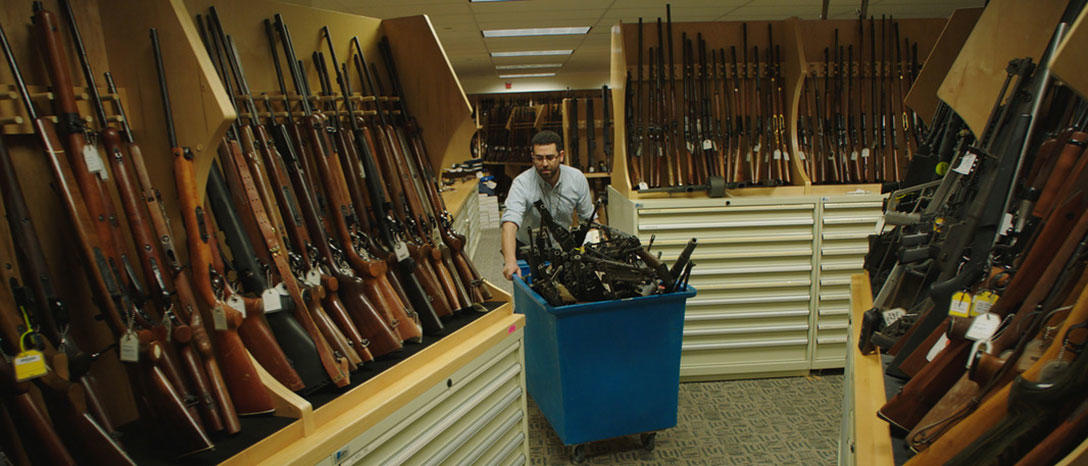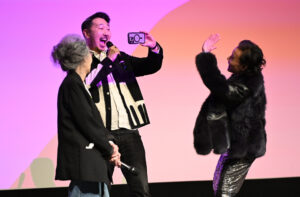Sundance Institute
Sundance.org is dispatching its writers to daily screenings and events to capture the 10 days of festivities during the 2016 Sundance Film Festival in Park City, Utah. Check back each morning for roundups and insights into our experiences throughout the Festival.
Under the Gun
By Jeremy Kinser
Under the Gun brought director Stephanie Soechtig and producer Katie Couric back to Sundance two years after Fed Up, an examination of childhood obesity, screened. Their latest, a devastating non-fiction look at America’s gun violence epidemic, premiered at the Marc Sunday night to a packed auditorium.
Soechtig’s film combines both statistics (“22 people in America will be shot” during the doc’s 110 minutes running time) and moving first-hand stories from family members who’ve survived victims of some of the country’s most notorious mass shootings. Many members of the audience could be seen wiping tears as the parents recounted the heartbreaking loss of their young children to gun violence.
Yet, rather than becoming a screeching polemic that plays to its intended audience, Under the Gun is a fair look at both sides of the national debate. Soechtig offers a history lesson filled with archive footage, showing how legislation about gun violence has evolved since the assassinations of the Kennedys and Martin Luther King. Her camera also interviews members of the NRA and shared the sometimes surprising reasons they joined the group — discounts at shooting ranges.
The Q&A that followed the screening served as an urgent call to action, with many of the extraordinary parents who had shared their stories in the film appearing in person and sharing various resources, most listed on the doc’s website. Couric, who also narrated the film, and Soechtig both encouraged people to become involved, urging the audience that despite President Obama’s recent executive action on stronger background checks before guns can be purchased, there is still more work to be done. “Congress might not fund the additional FBI agents and might not be able to enforce the laws on the books,” Couric stated. “While I think it was clearly a step in the right direction, it by no means means that we’re home free and don’t have to continue the pressure that ballot initiatives in various states shouldn’t go on.”
Mark Kelly, husband of Congresswoman Gabrielle Gifford, who, was shot in the head at point-blank range in 2011, and who is featured in the film, acknowledged the importance of the film.“I was thinking that this is a fantastic education on the issue,” he told the audience. “Here’s a place where you can go and sit for 90 minutes and become informed. We need people to be informed because when they’re informed it’s easier to reason with them. That’s why I think this movie is really great.”
In a more personal plea, Mark Barden, whose seven-year-old son Daniel was murdered in the Sandy Hook Elementary School shooting, offered a message on behalf of the others. “This shattered my family,” he said. “We hope you don’t look at us as victims, but as a symbol of hope. You are with us in this journey.”
Dark Night
The seemingly mundane events in the lives of a number of young people that lead up to a mass shooting in a suburban movie theater are depicted in Tim Sutton’s chilling, unsettling Dark Night. The ripped-from-the-headlines drama premiered Sunday at the Library Theatre in the NEXT section, making Sutton the first filmmaker to screen a second time in the category, following his 2014 effort Memphis.
Acknowledging his film’s challenging subject matter prior to the screening, Sutton told the audience he had “tried to make something beautiful and meaningful and thought-provoking about the world we live in right now.”

Despite an abundance of gun violence-themed films in the festival this year and perhaps inevitable comparisons to Gus Van Sant’s 2003 Elephant, Sutton uses a fragmented narrative to offer a unique and at times very lyrical look into how the lives of several young people whose fates will be tragically connected. The director uses long takes and tracking shots in which not much seems to be happening to create suspense and a feeling of dread. Sutton also incorporates mournful songs from Canadian musician Maica Armata to serve as a kind of narration and connecting device for the various story arcs.
Asked after the screening how Dark Night might contribute to the ongoing national conversation about gun violence, Sutton insisted his film isn’t a gun control movie. “What I think it does is add a new lens to the landscape this country is in right now,” he offered. “It’s as much about disconnection, it’s as much about the screens, it’s as much about isolation, that life is beautiful and we’re not aware of it. It contributes to the conversation in a way that isn’t about data, that isn’t about facts and figures. It’s about feeling something for these people and projecting your own lives up on the screen.”
As for whether the film could possibly insight copycat violence, Sutton said that of course he’s horrified by the thought, but insisted again that his film is not intended as a statement for gun control. “This movie is purposely neutral,” he asserted. “It’s observational. It’s not saying yes or no to guns. It’s just saying here are guns.”
Newtown
There was scarcely a dry eye in the house for the world premiere of Newtown at the Temple Theater on Sunday afternoon, from the film’s wrenching remembrance of the tragedies of December 14, 2012, that left 20 children and 6 educators dead, on through the post-screening Q&A in which 4 of the surviving parents spoke candidly to the audience. The film revisits Newtown, Connecticut, three years after those events changed the town and its inhabitants forever, exploring the various ways that survivors have tried to endure, agitate for change, and further the legacies of their lost loved ones.

Considering the emotional costs of consenting to a project such as this, what made this the right time to collaborate with veteran director Kim A. Snyder and producer Maria Cuomo Cole? As they discussed after the movie, there had been many previous offers. “As you can imagine, in the days and weeks and months” after the incident “we were just besieged with press requests from all over the world, and we chose to speak to a tiny, tiny fraction of that,” Mark Barden said, and he was echoed by Nicole Hockley. “At the start everybody wanted a piece of you. I became very untrusting of people,” she said. “When Kim approached, I put her through the ringer quite a few times before I allowed my family to be involved. But the thing is I kept allowing her to come back because there was something there that was different. I didn’t feel that there was an agenda. It wasn’t ‘I want you to do this, or cry here, or say these things.’ It was more heartfelt and genuine and sincere. Through the course of the two years, I’ve become completely trusting of Kim and Maria in every way possible.”
“We know this story has to be told. We felt it was very important for the vast majority of people who really care to see this window into what this is, and how deep it goes,” said Barden. “We knew that Kim and Maria were on to something. And now we have,” in the form of the film, “a beautiful, heart-wrenching gut punch that is going to reach a lot of people.”
When asked how and when they all saw Newtown for the first time, Snyder said she’d finished the film just 6 days prior, but still managed to travel to Connecticut to provide a private showing for the key people involved with the film before this public debut at the Festival.
“I don’t know how many of you have ever seen yourself on a screen, but it’s the most surreal thing in the world,” Hockley said. “And when it’s about your life, and it’s about your community, and it’s about your child and these circumstances, you can’t wrap your head around it.”
“It just wiped us out, like it did tonight,” Barden said. “Seeing the footage of our little Daniel up there just kills me. Hearing his little voice. It’s something that I can’t really do at home yet. I haven’t been able to get to that place. So it just floors me. At the same time, that setting with those people that we love around us, we got a lot of strength and power from them.”
Both Snyder and Hockley echoed the value of showing the film to the community, where dialogue about the tragedies can still be strained. “It is hard to understand some of the deep fractures that remain in Newtown. And how difficult it is to have conversations with one another,” Hockley said. “People don’t know what to say to you. That night, though, there were some wonderful conversations, and true moments of community.”
“There are really challenging fractures,” Snyder said. “As an outsider who was able to witness some of the dignity that hopefully you saw [in the movie], these gestures, small steps. I’m hoping some of the town will see that mirror, and just keep going.”
“I think it’s inevitable. I think people will be able to put aside the part of the process that doesn’t allow them to be open to something like this,” said David Wheeler, who was also skeptical of becoming involved with the film before becoming one of it’s most profound voices. “The way you grieve, especially traumatic grief, is as individual as your fingerprints or retinal scan. That is the essential reason for the differences in how we process and how we move through these things, which creates these fissures and these difficulties. I think this film could go a long way toward bringing some of those together.”







